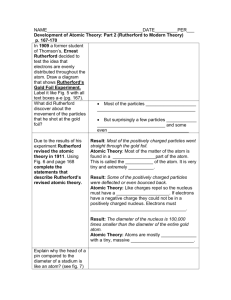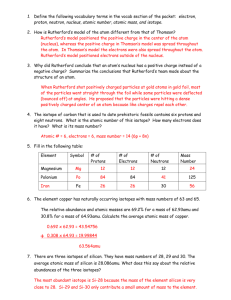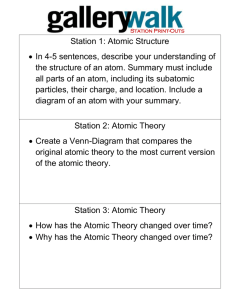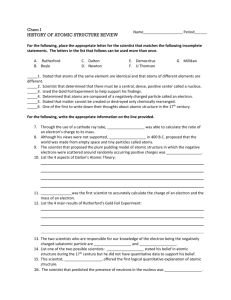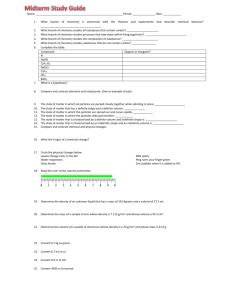Historical Development of the Atom Model
advertisement
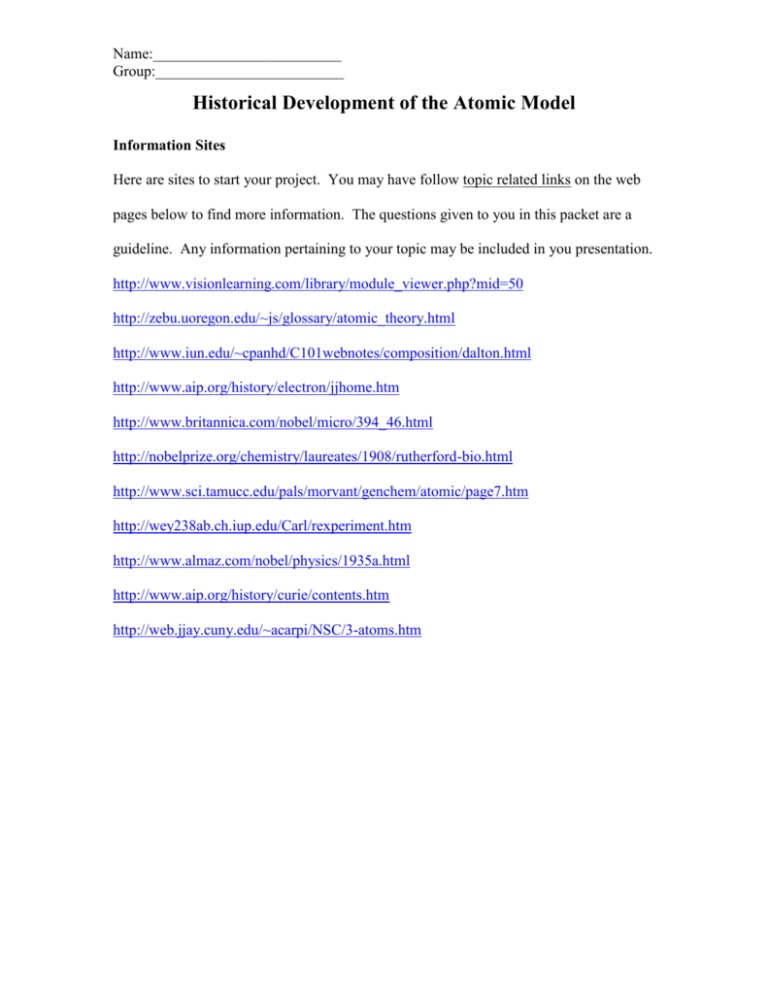
Name:_________________________ Group:_________________________ Historical Development of the Atomic Model Information Sites Here are sites to start your project. You may have follow topic related links on the web pages below to find more information. The questions given to you in this packet are a guideline. Any information pertaining to your topic may be included in you presentation. http://www.visionlearning.com/library/module_viewer.php?mid=50 http://zebu.uoregon.edu/~js/glossary/atomic_theory.html http://www.iun.edu/~cpanhd/C101webnotes/composition/dalton.html http://www.aip.org/history/electron/jjhome.htm http://www.britannica.com/nobel/micro/394_46.html http://nobelprize.org/chemistry/laureates/1908/rutherford-bio.html http://www.sci.tamucc.edu/pals/morvant/genchem/atomic/page7.htm http://wey238ab.ch.iup.edu/Carl/rexperiment.htm http://www.almaz.com/nobel/physics/1935a.html http://www.aip.org/history/curie/contents.htm http://web.jjay.cuny.edu/~acarpi/NSC/3-atoms.htm Name:_________________________ Group:_________________________ Atomic Theory 1. The Chemical Atomic Theory was introduced in the work of John Dalton. He made 4 postulates regarding Atomic Theory. What are they? 1. All mater is composed of atoms 2. Atoms of same elements are the same 3. Atoms of different elements are different 4. Atoms unite in definite whole number ratios when they form compounds. 2. What is the law of constant composition? A relation stating that the relative masses of elements are fixed in a given chemical substance 3. What is the law of conservation of mass? A relation stating that in a chemical reaction, the mass of the products equals the mass of the reactants. 4. What is the law of multiple proportions? A law proposed by Dalton which states that when elements combine, they do so in the ratio of small whole numbers. 5. With your group, design a poster or power point presentation of your findings. Presentation should be 5-7 minutes in length. Name:_________________________ Group:_________________________ John Dalton 1. When was John Dalton born and where he did live? He was born Sept. 6, 1766 and lived in England 2. What is Dalton primarily known for? His Atomic Theory 3. Name three other things he studied and made important discoveries in. In his work on the aurora he concluded that some relationship must exist between the aurora beams and the Earth's magnetism. Some of his studies in meteorology led him to conclusions about the origin of trade winds involving the Earth's rotation and variation in temperature. Along with his other researches he also became interested in color blindness, a condition that he and his brother shared. The results of this work were published in an essay, "Extraordinary Facts Relating to the Vision of Colors" (1794), in which he postulated that deficiency in color perception was caused by discoloration of the liquid medium of the eyeball. 4. With your group, design a poster or power point presentation of your findings. Presentation should be 5-7 minutes in length. Name:_________________________ Group:_________________________ J.J.Thomson 1. When was J.J. Thomson born and where he did live? He was born December 18, 1856 and lived in England 2. As a professor, what was the subject of Thomson’s research? He worked in physics trying to craft mathematical models that would reveal the nature of atoms and electromagnetic forces 3. What is Thomson credited with discovering? The electron. 5. What piece of equipment did he use for his famous discovery? The cathode ray tube. 6. What did he call his discovery at first? He called these particles "corpuscles," and suggested that they might make up all of the matter in atoms. 7. With your group, design a poster or power point presentation of your findings. Presentation should be 5-7 minutes in length. Name:_________________________ Group:_________________________ Cathode Rays 1. What is a cathode ray? It is a special-purpose electron tube in which electrons are accelerated by highvoltage anodes, formed into a beam by focusing electrodes, and projected toward a phosphorescent screen that forms one face of the tube. 2. Name a modern use of the cathode-ray tube. Television sets, computers, automated teller machines, video game machines, video cameras, monitors, oscilloscopes and radar displays all contain cathode-ray tubes. 3. Who “discovered” the electron and when ? J.J. Thompson in 1897. 4. Sketch a cathode-ray tube and label it with the following parts: Partially evacuated glass vessel, electrically charged plates, cathode, anode, magnet, electron path, fluorescent screen, high voltage source. Explain how it works. Name:_________________________ Group:_________________________ 5. With your group, design a poster or power point presentation of your findings. Presentation should be 5-7 minutes in length. Name:_________________________ Group:_________________________ Milliken Oil-Drop Experiment 1. When was Robert Milliken born and where he did live? He was born March 22, 1868 in the United States 2. The Milliken oil-drop experiment succeeded in measuring what? The charge on an electron 3. When was the experiment performed? 1910 4. Sketch a representation of Milliken’s oil-drop apparatus and label the following: atomizer, oil spray, viewing microscope, electrically charged plates. Explain how the apparatus works. An atomizer sprayed a fine mist of oil droplets into the chamber. Some of these tiny droplets fell through a hole in the upper floor. Millikan first let them fall until they reached terminal velocity. Using the microscope, he measured their terminal velocity, and by use of a formula, calculated the mass of each oil drop. Next, Millikan applied a charge to the falling drops by illuminating the bottom chamber with x-rays. This caused the air to become ionized, and electrons to attach themselves to the oil drops. By attaching a battery to the plates above and below this bottom chamber, he was able to apply an electric voltage. The electric field produced in the bottom chamber by this voltage would act on the charged oil drops; if the voltage was just right, the electromagnetic force would just balance the force of gravity on a drop, and the drop would hang suspended in mid-air. Name:_________________________ Group:_________________________ 5. Name three other subjects that Milliken researched. The fields of electricity, optics, and molecular physics. 6. With your group, design a poster or power point presentation of your findings. Presentation should be 5-7 minutes in length. Name:_________________________ Group:_________________________ Ernest Rutherford 1. When was Ernest Rutherford born and where did live? He was born August 30, 1871 in New Zealand 2. What were the subjects of his first researches (List two)? Rutherford's first researches, in New Zealand, were concerned with the magnetic properties of iron exposed to high-frequency oscillations, and his thesis was entitled Magnetization of Iron by High-Frequency Discharges. He was one of the first to design highly original experiments with high-frequency, alternating currents. His second paper, Magnetic Viscosity, was published in the Transactions of the New Zealand Institute (1896) and contains a description of a time-apparatus capable of measuring time intervals of a hundred-thousandth of a second. 3. In 1898 he reported the existence of what? In 1898 he reported the existence of alpha and beta rays in uranium radiation and indicated some of their properties. 4. What is the “disintegration theory”? The nuclei of certain light elements, such as nitrogen, could be "disintegrated" by the impact of energetic alpha particles coming from some radioactive source, and that during this process fast protons were emitted. 5. What significant experiment is Rutherford known for? Gold Foil Experiment 6. With your group, design a poster or power point presentation of your findings. Presentation should be 5-7 minutes in length. Name:_________________________ Group:_________________________ Gold Foil Experiment 1. Rutherford’s gold foil experiment led to the downfall of the “plum pudding” model. Explain the gold foil experiment and its results. Include a schematic. The Gold foil experiment was an experiment done by Ernest Rutherford to determine the layout of the atom. He determined this by bombarding gold foil with alpha particles, and observing the scattering of these particles, a procedure requiring many hours in a darkened room watching for tiny flashes of light as the scattered particles struck a scintillant screen. Rutherford was surprised to observe that most of the particles passed through the foil without any deflection; under the plum pudding model, charge would be distributed thickly in the foil, and very few particles would avoid deflection. This result implied that, on the contrary, most of the apparently solid metal was, in fact, empty space. Even more surprising, a tiny number of the particles underwent larger deflections in their path: some were even bounced back from the foil. Under the plum-pudding model, thus is akin to a sheet of paper to bouncing back bullets. Name:_________________________ Group:_________________________ 2. With your group, design a poster or power point presentation of your findings. Presentation should be 5-7 minutes in length. Name:_________________________ Group:_________________________ Sir James Chadwick 1. When was Chadwick born and where did he live? He was born October 20, 1891 in England 2. What did he accomplish with Rutherford? In Cambridge, Chadwick joined Rutherford in accomplishing the transmutation of other light elements by bombardment with alpha particles, and in making studies of the properties and structure of atomic nuclei. 3. What did he prove the existence of? He proved the existence of neutrons. 4. What did he do from 1942-1946? He worked in the United States as Head of the British Mission attached to the Manhattan Project for the development of the atomic bomb. 5. With your group, design a poster or power point presentation of your findings. Presentation should be 5-7 minutes in length. Name:_________________________ Group:_________________________ Marie Curie 1. When and where was Marie Curie born? She was born on November 7, 1867, in Warsaw, the city that had once been the capital of Poland. 2. What is she famous for discovering (define or explain)? Radioactivity, which was not the result of a chemical reaction but a property of the element or, more specifically, of the atom. It it based on the Latin word for “ray” and describes the rays of energy that are emitted. 3. What elements did she use in her research? Uranium, polonium, radium 4. What were some problems she ran into during her research (list two)? Her early researches, together with her husband, were often performed under difficult conditions, laboratory arrangements were poor and both had to undertake much teaching to earn a livelihood. Also, some of her work and theories were disregarded. 5. List 4 major breakthroughs in her research. The isolation of polonium, named after the country of Marie's birth, and radium. Developed methods for the separation of radium from radioactive residues in sufficient quantities to allow for its characterization and the careful study of its properties, therapeutic properties in particular. Together with her husband, she was awarded half of the Nobel Prize for Physics in 1903, for their study into the spontaneous radiation discovered by Becquerel, who was awarded the other half of the Prize. In 1911 she received a second Nobel Prize, this time in Chemistry, in Name:_________________________ Group:_________________________ recognition of her work in radioactivity. She also received, jointly with her husband, the Davy Medal of the Royal Society in 1903 and, in 1921, President Harding of the United States, on behalf of the women of America, presented her with one gram of radium in recognition of her service to science. 6. With your group, design a poster or power point presentation of your findings. Presentation should be 5-7 minutes in length. Name:_________________________ Group:_________________________ Modern View 1. Define atom. A single unit of an element is called an atom. The atom is the most basic unit of the matter that makes up everything in the world around us. Each atom retains all of the chemical and physical properties of its parent element. 2. Define proton. What is its mass and charge? Protons are much larger and heavier than electrons and have the opposite charge, protons have a positive charge. The proton has a charge of +1 electron charge (or, +1.602 x 10-19 C). It has a mass of 1.6726231e-27 ±; 1.0e-33 kg 3. Define neutron. What is its mass and charge? Neutrons have no charge, they are electrically neutral. Neutrons are large and heavy like protons. It has a mass of 1.6749286e-27 ±; 1.0e-33 kg 4. Define electron. What is its mass and charge? Electrons are tiny, very light particles that have a negative electrical charge (-) with a charge of -1.602 x 10-19 Coulombs (C). It has a mass of 9.1093897e-31 ±; 5.4e-37 kg 5. How do the proton, neutron, and electron interact with each other? Protons and neutrons are located in the nucleus (center) of the atom. The nucleus is small compared to the overall size of the atom. The majority of the space of an atom is the space in which the electrons move around. Electrons are attracted to the protons in the nucleus by the force of attraction between particles of opposite charge. Name:_________________________ Group:_________________________ 6. Draw a diagram of an atom labeling the proton, neutron, and electron. 7. With your group, design a poster or power point presentation of your findings. Presentation should be 5-7 minutes in length.

